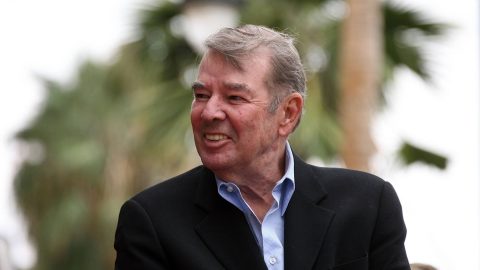NME Music News, Reviews, Videos, Galleries, Tickets and Blogs | NME.COM

The cinematic camera, when it falls for a particularly iconic figure, has the ability to grant immortality. For screen legend Sir Sean Connery, who died today aged 90, clashing claymores in the Scottish highlands as the immortal Don Juan Sanchez-Villalobos Ramirez in 1986’s Highlander was merely a prescient move; the actor will live forever in his smouldering portrayal of the first – and unarguably best – James Bond, and in his unique, to date, ability to transcend the role to Oscar-winning effect.
Born Thomas Sean Connery into a working-class Edinburgh family in 1930, his early career suggested anything but a life before the cameras. At 16 he joined the navy, and would go on to work as a lifeguard, artist’s model and coffin polisher, while competing in bodybuilding contests. He became known as something of an Edinburgh hard man too, when he took on a mob of local gang members single handed. A job backstage at the King’s Theatre inspired him to try acting and he swiftly ascended through the ranks of a 1953 touring production of Rodgers and Hammerstein musical South Pacific until he was among the leads. Roles in theatre, TV drama and as a minor player in films followed, until more substantial parts in 1958’s Another Time, Another Place and Walt Disney’s Darby O’Gill And The Little People (1959) raised his profile to the point where he could be considered for the role of Ian Fleming’s legendary 007. “I’m looking for Commander Bond, not an overgrown stunt man,” Fleming said of his casting, but changed his mind following Connery’s riveting performance in Bond’s 1962 cinematic debut Dr No.

Connery’s tenure as Bond over the first five films between 1962 and 1967 (Dr No, From Russia With Love, Goldfinger, Thunderball and You Only Live Twice) gave popular cinema some of its most memorable scenes – not least Goldfinger exclaiming, “No, Mr Bond, I expect you to die!” as he leaves Connery alone with the laser beam inching towards his nether regions – but also dramatically defined the role. He became almost un-followable: George Lazenby lasted only one film as his successor before Connery was invited back for 1971’s Diamonds Are Forever, and Roger Moore was only able to make the role his own by playing on its cartoonish camp. Yet Connery was acutely wary of the role defining him. While playing Bond he also appeared in such movies as Alfred Hitchcock’s Marnie (1964) and comedy The Hill (1965) – and once he’d shed the tuxedo he was at pains to take roles that distanced himself from Bond. In 1974 he was to be found in a sci-fi mankini and thigh high boots in John Boorman’s sci-fi fantasy Zardoz; the following year he appeared in the celebrated adventure adaptation of Rudyard Kipling’s The Man Who Would Be King alongside long-term friend Michael Caine, a film which both actors would claim was their favourite to work on. In 1976’s Robin and Marian he took on the role of Robin Hood and, alongside war and crime movies, fantasy roles were plentiful, most notably as King Agamemnon in 1981’s Time Bandits and as an Egyptian immortal in Highlander, for which Connery became almost as much of a figurehead as he had for Bond.

When Connery decided to reprise his role as 007 in 1983’s Never Say Never Again – the first and only Bond movie not to be made by Eon Productions – he was careful to balance it with some of his most thoughtful and respected work. Playing Franciscan friar William von Baskerville in 1986’s medieval murder mystery The Name Of The Rose and Jim Malone in 1987’s mobster classic The Untouchables, for which he received the Academy Award for Best Supporting Actor, marked Connery out as an acclaimed and serious actor as much as a popular sex symbol, setting him up for weighty leads in thrillers such as The Hunt For Red October and The Russia House (both 1990). Irregular blockbuster appearances would characterise his later work – in the likes of 1996’s The Rock, 1998’s The Avengers, 2003’s The League Of Extraordinary Gentlemen – but he still found time for acclaimed dramatic roles such as the title role of Gus Van Sant’s Finding Forrester (2000).
Having received lifetime achievement awards from the Golden Globes and the American Film Institute – and turned down the role of Gandalf in The Lord Of The Rings, which would have netted him around $450 million – Connery retired from acting in 2007, able to look back on a career that wasn’t short on action behind the camera too. A choreographed fight with Steven Segal on Never Say Never Again left Connery with a broken wrist, and back in 1958, while working on Another Time, Another Place, he single-handedly disarmed the gun-toting gangster boyfriend of his co-star Lana Turner when he turned up on set believing Connery and Turner were having an affair. Though his reputation was tarnished somewhat by allegations of abuse in the 2006 autobiography of his ex-wife Diane Cilento, his screen work placed Connery amongst cinema’s most revered immortals.
The post Sean Connery – 1930-2020: larger-than-life film legend who transcended his biggest role appeared first on NME Music News, Reviews, Videos, Galleries, Tickets and Blogs | NME.COM.


